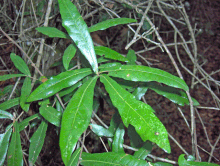Quercus hemisphaerica
| Quercus hemisphaerica | |
|---|---|

| |
| Scientific classification | |
| Kingdom: | |
| (unranked): | |
| (unranked): | |
| (unranked): | |
| Order: | |
| Family: | |
| Genus: | |
| Section: | |
| Species: | Q. hemisphaerica
|
| Binomial name | |
| Quercus hemisphaerica Bartram ex Willd. 1805 not Drake 1890 nor Endl. 1848
| |
| Synonyms[1] | |
|
List
| |
Quercus hemisphaerica (sand laurel oak, laurel oak, Darlington oak, laurel-leaf oak) is a species of oak native to the southeastern and south-central United States, from Texas to Delaware.[2] It is in the red oak section Quercus sect. Lobatae. It is often confused with and closely related to the Quercus laurifolia (swamp laurel oak) in which it differs in several key characteristics.
Quercus hemisphaerica is a medium-sized evergreen to semi-evergreen tree which can grow as tall as 115 feet (35 m) tall with a 5-foot (1.5 m) trunk diameter, although it is more commonly around 60 to 65 feet (18 m-20 m) tall. The leaves are entire, without teeth except one apical awn (rarely with a few teeth near apex), mostly elliptical or narrowly ovate, and 1.2 to 4.7 inches (3 cm to 12 cm) long by 0.4 to 1.6 inches (1 cm to 4 cm) wide. The petiole is very short ranging from 1/25 to 1/5 of an inch(1 mm to 5 mm) long and the leaf base is obtuse to rounded. The acorns are hemispheric in shape and 0.35 to 0.6 inches(9 to 16.5 mm) by 0.35 to 0.6 inches(9 to 16.5 mm). The acorns take 18 months to mature and are 1/4 to 1/3 covered by a saucer to bowl shaped cap.[3]
It grows in somewhat xeric sandy soils, sand hills, and sometimes on hillsides.
There is at least one known hybrid involving Quercus hemisphaerica which is with Q. laevis (Q. × mellichampii Trel.).
Key differences between sand laurel oak and swamp laurel oak

- When both sand laurel oak (Q. hemisphaerica) and swamp laurel oak (Quercus laurifolia) are growing in the same area, sand laurel oak will flower about two weeks later than the swamp laurel oak.
- Sand laurel oak grows on dry sandy soils while swamp laurel oak grows on flood plains, river bottoms, and occasionally poorly drained upland soils.
- Sand laurel oak has narrow ovate or elliptic leaves, while swamp laurel oak has rhombic or broad ovate leaves.
- Sand laurel oak has an acute leaf apex and a rounded or obtuse (blunt, >90°) leaf base, while swamp laurel oak has an obtuse or rounded leaf apex and a cuneate or attenuate leaf base.
- Sand laurel oak is mostly evergreen, while swamp laurel oak is mostly tardily deciduous.
References
External links
- North Carolina State Fact Sheet: Laurel Oak
- Auburn University, Trees of Alabama and the Southeast: Laurel Oak
- Virginia Tech, Department of Forestry Fact Sheet: Darlington oak
- United States Department of Agriculture plants profile: Darlington oak
- Floridata: Quercus hemisphaerica
- Institute of Food and Agricultural Sciences, University of Florida: Laurel Oak or Swamp Laurel Oak?
